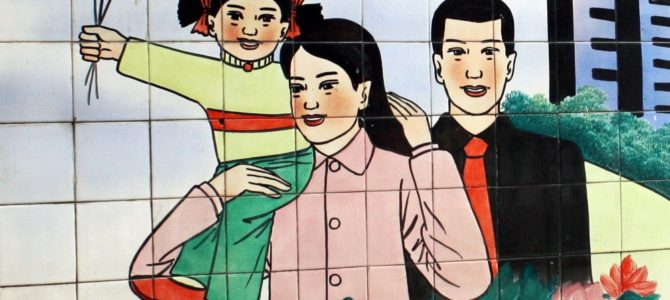
Forty years ago, on September 25, 1980, the Central Committee of the Chinese Communist Party sent a letter to all party members, urging them to support the Party’s “one-child” policy. The “one-child” policy was the brainchild of CCP leader Deng Xiaoping. After more than two decades of endless political movements and disastrous socialist policies, Deng’s predecessor, Mao Tse-dung, left behind an impoverished nation on the verge of collapse.
When Deng assumed power in 1978, China’s gross domestic product per capita was only $156 — much less than Mexico’s $1,580. Deng recognized that the only way to save the CCP’s one-party rule in China was to get the economy going. He regarded the size and growth of China’s population as an obstacle to his plan to revive China’s economy.
So the “one-child” policy was launched in China in 1980, limiting each Chinese family to one child. It was, and remains, the most restrictive population policy in human history.
The National Population and Family Planning Commission
From the start, especially in rural China, the policy was deeply unpopular. As traditional Chinese culture regards more children as indications of further blessings from heaven, even an authoritarian regime had to bow to pressure from time to time. The CCP made several exceptions over the years. For example, if one of the parents belonged to an ethnic minority, the couple could have two children; if the couple’s first child had disabilities, the couple could have another child.
To implement the one-child policy, Deng established a new bureaucracy called the National Population and Family Planning Commission. Unsurprisingly, in the ensuing years, the NPFPC grew into a giant bureaucracy with half a million full-time employees and 85 million part-time employees.
The NPFPC enforced the one-child policy through several means, including “birth permits” requiring married couples to apply for authorization before they could have a child. Children born without a birth permit couldn’t enter the household registration system, meaning they wouldn’t receive food rations and would face challenges enrolling in schools and finding regular employment later in life.
Another means of control was sterilization. After a couple had one child, or in some instances after having two children, the woman was required to undergo sterilization (occasionally men were asked to be sterilized too). Chinese women feared these procedures, which could cause long-term side effects, including menstrual cycle changes, hysterectomies, or various types of cancer. Chinese women, however, didn’t have much choice.
According to Mei Fong, author of “One Child: The Story of China’s Most Radical Experiment,” in 1983, “China sterilized over 20 million people, more than the combined population of the three largest US cities, New York, Los Angeles, and Chicago.”
Policing the Policy
The NPFPC established neighborhood cell groups to help it track Chinese couples. Mei Fong says each cell was usually made up of 10 families and the cell leader was but one member of the NPFPC’s army of part-time employees.
A cell leader earned about $60 a year for acting as the eyes and ears for the NPFPC, with responsibilities including distributing NPFPC propaganda about the benefits of having only one child per couple and closely monitoring their neighbors’ reproductive activities, such as who had recently married and who was pregnant. The information was passed to higher-ups in the NPFPC.
Cell leaders also bore responsibility for “persuading” neighbors who already had children to undergo sterilization. If any of the neighbors refused to be sterilized or became pregnant with a second or third child, the cell leader notified the local NPFPC to take action.
Couples violating the “one-child” policy were punished in numerous ways. The most “humane” punishment was a heavy fine that ranged between two to ten times the couple’s annual income. The wide range of fines reflected the fact that local NPFPCs had a great deal of latitude to decide the severity of punishment based on local culture, economic conditions, and most importantly, the zeal for the policy held by a given NPFPC enforcer. When dealing with poorer couples who couldn’t afford the fine, NPFPC enforcers would barge into homes, search for the couple’s most valuable possessions, and haul them away.
The cruelest punishment, however, was forced abortion. The last time I visited China, a friend told me that her neighbor was eight-months pregnant with her second child when the local NPFPC enforcers came to her house, dragged her into a car, and drove her to a local hospital to have an abortion. The nurses had to sedate the mother to perform the procedure. When the poor mother woke up and learned her baby had been murdered, she suffered a mental breakdown. She never recovered.
The New York Times reported a similar story about Feng Jianmei, who had a stillborn child in 2012 after local officials forced her to abort her child. Her husband was beaten by NPFPC enforcers, who called the couple “traitors.” The heart-wrenching documentary “It’s a Girl” is one of the best films detailing how the NPFPC enforced the “one-child” policy.
Despite all the unimaginable cruelty of the “one-child” policy and its enforcement, NPFPC Commissioner Qian Xinzhong, won the first United Nations Population Award in 1983, for his “outstanding contributions” to solving “the population question.”
A Small Admission
In recent years, even Beijing has realized the long-term negative consequences of its “one-child” policy. First, since Chinese families traditionally value sons more than daughters because sons are expected to carry on family names and lead annual worship of ancestors, some families either chose abortion as soon as they learned they were expecting girls, or abandoned the baby girls after they were born. Some directly committed infanticide.
The Chinese government tried to address the problem by allowing couples living in rural areas to have a second child if their first was a girl. It’s difficult to assess how effective the approach was since the Chinese government treats its family planning data as a “state secret.” What we do know is that China currently faces a massive sex imbalance: men outnumber women by 32 million.
All kinds of problems emerge when young men can’t find wives. Human Rights Watch reports that women and girls from China’s neighboring countries such as Cambodia and Vietnam have been tricked by brokers with the false promise of employment in China. Once these women and girls arrive in China, they are sold as brides to Chinese men. So far, the Chinese government has done little to address the growing bride-trafficking problem. Instead, Chinese authorities focus on preventing media from covering the issue.
New Demographic Problems for China
A second long-term consequence of the “one-child” policy is that it has driven down the birth rate in China. A lower birth rate, in conjunction with improved health care, has bequeathed China a rapidly aging population. Mark Haas, a political science professor at Duquesne University, writes:
China alone in 2050 will have more than 329 million people over 65, which is equal to the entire current population of France, Germany, Japan, and the United Kingdom combined.
China’s three decades’ of breakneck economic growth were closely tied to its large pool of young and affordable workers. As this pool of labor thins, China’s economic growth has slowed significantly. As such, many experts predict China will be the first major economy to grow older before it gets richer.
Recognizing these problems but unwilling to acknowledge its mistake, the CCP tried to engineer a baby boom by turning its “one-child’ policy into a “two-child” policy. It announced that starting in 2016, all Chinese families would be allowed to have two children. People’s Daily, China’s state-run newspaper, declared in an editorial, “the birth of a baby is not only a matter of the family itself but also a state affair.”
The baby boom the Chinese government hoped for never happened. Chinese women, who have suffered enough under one forced state experiment, simply refuse to become lab rats of another social engineering project.
Lessons that Still Need to be Learned
Forty years since its introduction, the “one-child” policy has left a blood-soaked legacy. Yet, we shouldn’t treat it as an entirely Chinese phenomenon. Indeed, the intellectual foundation of China’s Malthusian approach came from the West.
From English political economist Thomas Malthus’s 1798 treatise “An Essay on the Principle of Population” to the 1968’s “The Population Bomb” by Stanford University Professor Paul R. Ehrlich and his wife, Anne Ehrlich, plenty of Western intellectuals, policymakers, and environmentalists have advocated for state interventions to reduce population growth to allegedly conserve resources.
Even after the horrors of China’s population policy became known, John Holdren, who advised President Obama on science matters, co-wrote the third edition of “Ecoscience: Population, Resources, Environment” with Paul and Anne Ehrlich, suggesting a new bureaucracy be “given responsibility for determining the optimum population for the world” so each nation can set a population limit.
These population alarmists couldn’t be more wrong. From 1980 to 2018, the world population has grown from 4.45 billion to 7.6 billion, while extreme poverty (living less than $1 per day) has been cut in half. As British scientist Matt Ridley rightly concludes, “the solution to the population crisis lay in prosperity, not coercion.” One day, perhaps we’ll finally learn that lesson — hopefully, before the next evil government population control policy has a chance to cause further death and suffering.









